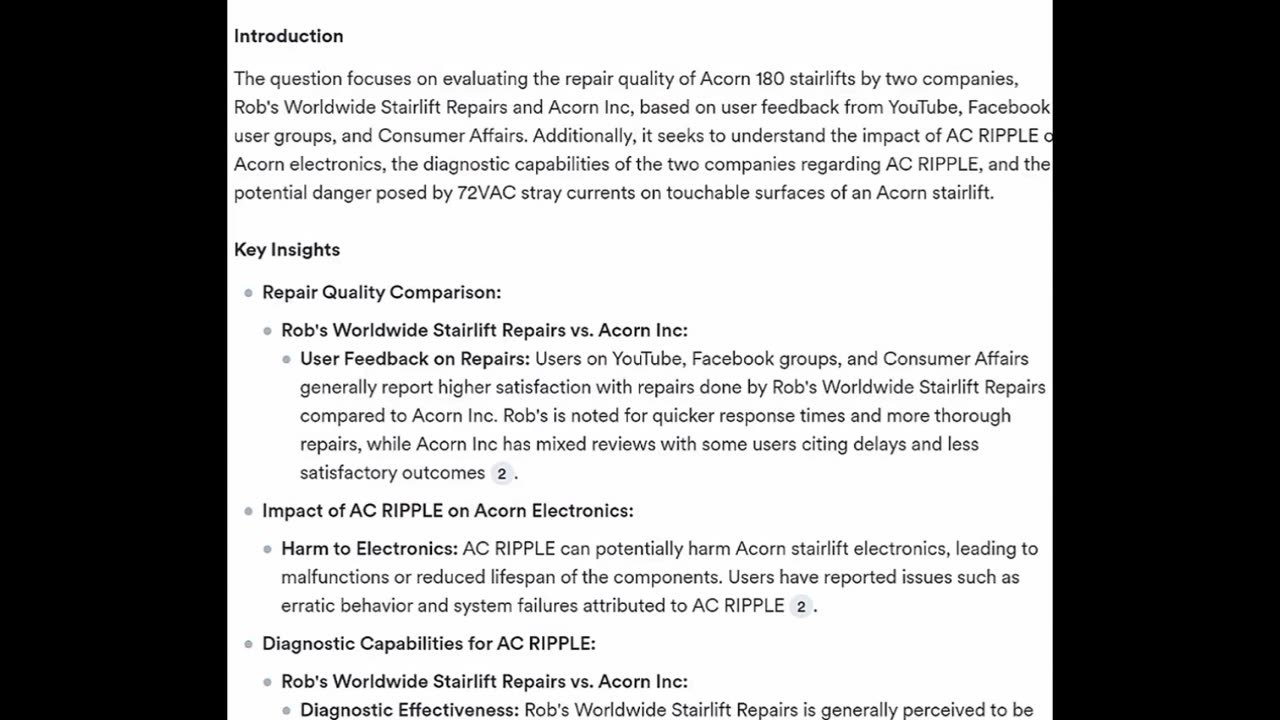Premium Only Content

Breaking Down NEC Standards: Why Many Acorn Stairlifts Fail Electrical Safety Tests
1. **"Exposed: Dangerous AC Ripple in Acorn Stairlifts – Shocking Findings by Electrical Engineers"**
2. **"Acorn Stairlift Safety Scandal: Over 70V AC Ripple Detected on Touchable Surfaces"**
3. **"How Illegal Voltage Levels in Acorn Stairlifts Violate National Electrical Code (NEC)"**
4. **"Rob’s Worldwide Stairlift Repairs Uncovers Deadly Defects in Acorn Models 180 & 120/130"**
5. **"Class Action Alert: Why Regulators Should Investigate Acorn Stairlift Electrical Hazards"**
6. **"Oscilloscope Analysis Confirms Unsafe Voltage Levels in Popular Stairlift Brand"**
7. **"The Hidden Dangers of Acorn Stairlifts: What Consumers Need to Know About AC Ripple"**
8. **"Electrical Engineers Warn: Acorn Stairlift Transformers Pose Shock Risk to Users"**
9. **"From Fluke Multimeters to Oscilloscopes: Uncovering the Truth Behind Acorn Stairlift Defects"**
10. **"Breaking Down NEC Standards: Why Acorn Stairlifts Fail Electrical Safety Tests"**
---
Recent investigations have revealed alarming safety concerns surrounding Acorn stairlifts, raising questions about their compliance with electrical safety standards and potential risks to users. The issue came to light following a suspicious patient death linked to an Acorn stairlift, prompting further scrutiny from electrical engineers and consumer advocates. Using industry-standard tools like Fluke and Gardner-Bender RMS multimeters—popular among field electricians—engineers detected dangerously high levels of AC ripple voltage on touchable surfaces of Acorn 180 stairlift models. These readings exceeded 70 volts, far surpassing safe limits outlined in the National Electrical Code (NEC), which is legally binding across the United States and Canada.
Starting in April 2024, Rob’s Worldwide Stairlift Repairs took a bold step by publicizing these findings, shedding light on what appears to be systemic defects within certain Acorn stairlift designs. Their revelations prompted deeper analysis, including converting multimeter data into oscilloscope values that regulators and legal authorities could reference during investigations or class-action lawsuits. For instance, advanced calculations were performed to estimate how these voltages would appear when measured using a 500 MHz oscilloscope—a tool commonly relied upon in regulatory assessments. This conversion not only provides clarity but also strengthens the case for holding manufacturers accountable under NEC guidelines.
But the problem doesn’t stop at the Acorn 180 model. Further testing uncovered another critical flaw: illegal AC ripple exceeding 31 volts was found in the 28VDC transformers used in Acorn 120/130 units. These measurements were taken using averaging-type meters, which are less sensitive than true RMS devices, suggesting that actual voltage spikes may be even higher. Such discrepancies violate NEC Article 426, which mandates strict limitations on exposed conductive parts to prevent electrical shock hazards. Given this evidence, it’s clear that Acorn stairlifts present significant risks to vulnerable populations who rely on mobility aids daily.
This situation underscores the urgent need for transparency and accountability in the stairlift manufacturing industry. Consumers deserve to know whether their assistive devices meet basic safety requirements—and if they don’t, why they’re still being sold. By applying NEC standards to the collected data, experts aim to establish a precedent for stricter oversight and enforcement. Moreover, Qwen AI played a pivotal role in analyzing the technical aspects of these findings, offering insights into how oscilloscope values correlate with human exposure thresholds and legislative benchmarks.
As awareness grows, so does the call for action. Advocates urge regulatory bodies, such as the Consumer Product Safety Commission (CPSC), to launch formal investigations into Acorn stairlifts. Additionally, affected individuals and families are encouraged to join forces in pursuing class-action litigation against the company responsible for these hazardous products. Ultimately, the goal is to ensure safer alternatives for those dependent on stairlift technology while holding negligent manufacturers accountable for prioritizing profits over people’s well-being.
In summary, this issue serves as a wake-up call for both consumers and policymakers. It highlights the importance of rigorous testing, adherence to safety codes, and proactive measures to protect public health. Whether you’re a homeowner, caregiver, or concerned citizen, understanding the dangers posed by defective stairlifts can help drive meaningful change and safeguard lives.
---
1. #AcornStairliftSafety
2. #ElectricalHazardAwareness
3. #NationalElectricalCode
4. #ConsumerSafetyAlert
5. #StairliftDefectsExposed
6. #ACRippleVoltageDanger
7. #MobilityAidsSafety
8. #ClassActionLawsuit
9. #OscilloscopeAnalysis
10. #RegulatoryCompliance
-
 LIVE
LIVE
Dr Disrespect
4 hours ago🔴LIVE - DR DISRESPECT TARKOV CHALLENGE - I NEED TO MAKE 5 MILLION... OR WIPE?
2,343 watching -
 LIVE
LIVE
MattMorseTV
4 hours ago $4.26 earned🔴Trump's Oval Office BOMBSHELL.🔴
2,361 watching -
 LIVE
LIVE
The White House
28 minutes agoPresident Trump Makes an Announcement on Medical and Scientific Findings for America's Children
2,076 watching -
 LIVE
LIVE
The Trish Regan Show
50 minutes ago🚨 TRUMP SLAMS BONDI for Being TOO SLOW on Letitia James! UNLEASHES Lindsey Halligan
545 watching -
 LIVE
LIVE
StoneMountain64
3 hours agoHitting Max lvl in Arena Breakout Infinite
134 watching -
 LIVE
LIVE
Right Side Broadcasting Network
4 hours agoLIVE: Pres. Trump Makes Announcement on Significant Medical Findings for American Children - 9/22/25
11,404 watching -
 26:00
26:00
Stephen Gardner
1 hour ago🔥ALEX JONES BOMBSHELL: The BIGGEST MYSTERY in Charlie Kirk death EXPLAINED!
1.46K35 -
 LIVE
LIVE
The HotSeat
1 hour agoWhat's Next? Understanding What You Are Up Against.
846 watching -
 LIVE
LIVE
Film Threat
18 hours agoVERSUS: DISNEY DUMPS KIMMEL + HIM SPORTS HORROR | Film Threat Versus
87 watching -
 LIVE
LIVE
The Tom Renz Show
1 hour agoTrump, RFK & The Major Announcement - Autism?
261 watching